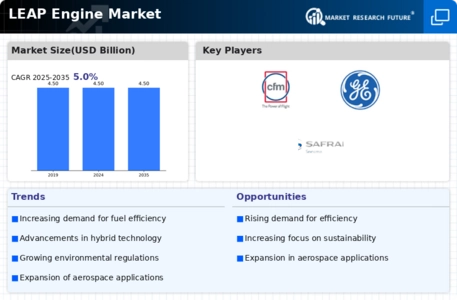Market Trends
Key Emerging Trends in the LEAP Engine Market
The Leap Engine market is undergoing significant developments and innovations, driven by the demand for more efficient and environmentally friendly propulsion systems in the aviation industry. This market, crucial for powering narrow-body commercial aircraft, is shaped by key trends that reflect advancements in technology, sustainability goals, and the need for improved fuel efficiency. One primary driver influencing the Leap Engine market is the industry's focus on fuel efficiency and reduced environmental impact. Airlines and aircraft manufacturers are increasingly seeking propulsion systems that offer better fuel efficiency, contributing to cost savings and aligning with global efforts to reduce carbon emissions. The Leap Engine's advanced design and materials contribute to its fuel efficiency, making it a sought-after choice for next-generation commercial aircraft.
Technological advancements play a pivotal role in shaping the trends within the Leap Engine market. The Leap Engine incorporates cutting-edge technologies, such as composite materials, advanced aerodynamics, and state-of-the-art manufacturing processes. These innovations contribute to the engine's overall performance, reliability, and fuel efficiency. Additionally, the integration of digital technologies, such as advanced sensors and data analytics, allows for more precise monitoring and maintenance, enhancing the engine's operational capabilities and reducing downtime.
The market is witnessing a transition towards more sustainable aviation practices, and the Leap Engine is positioned to address these environmental concerns. As the aviation industry strives to reduce its carbon footprint, engines that meet stringent emission standards become increasingly attractive. The Leap Engine's design includes features that contribute to lower emissions, making it a prominent choice for airlines looking to enhance their environmental sustainability and comply with evolving regulatory requirements.
The trend towards aircraft manufacturers adopting a more electric architecture is influencing the Leap Engine market. As aircraft systems become more electrified, there is a growing demand for propulsion systems that integrate seamlessly with these electrical systems. The Leap Engine incorporates advanced technologies, such as electrically driven accessories and more electrically efficient components, contributing to the overall electrification trend in modern aircraft design.
The market is experiencing a shift towards aftermarket services and solutions for the Leap Engine. Airlines and operators are seeking comprehensive maintenance, repair, and overhaul (MRO) services to ensure the continued reliability and performance of their Leap-powered aircraft. This trend reflects the recognition of the importance of aftermarket support in maximizing the operational life of the engines and optimizing the overall cost of ownership for airlines.
Collaborations and partnerships within the aviation industry are playing a crucial role in shaping the Leap Engine market. Engine manufacturers, aircraft OEMs, and airlines are engaging in collaborative efforts to enhance the performance and capabilities of propulsion systems. These partnerships aim to address specific challenges, such as improving fuel efficiency, reducing emissions, and developing next-generation technologies. Such collaborations contribute to the continuous improvement and innovation within the Leap Engine market.






Leave a Comment